Summary
For the fourth year in a row, Donald Trump dominates our list of the whoppers of the year.
Before he entered politics as a presidential candidate in 2015, we had never singled out one person as the most egregious teller-of-falsehoods in these year-end wrapups. But he continues to force our hand. We can’t ignore the evidence, and the evidence is overwhelming.
We selected 10 of Trump’s whoppers, and there were many more that could have made the cut.
The president exhibits a penchant not only for making inaccurate claims, but for adding new embellishments when he repeats them. For instance, his frequent false claim that “U.S. Steel is opening and expanding seven different plants,” became “eight or nine” in one retelling.
Trump also makes claims for which he offers no evidence, and the White House declines to provide any. One example: Trump claims an Uzbekistan national who was arrested for a deadly terrorist attack in New York City brought 22 people with him into the U.S. through “chain migration.” There’s no evidence that the man brought even one relative, and it would be impossible under the immigration system to bring “his uncle, his aunt, his brother, his nephew,” as the president claims.
Among his most newsworthy falsehoods were his denial that he knew anything about a hush-money payment to porn star Stormy Daniels during the 2016 campaign and his claim that he “never said Russia did not meddle in the election.”
Trump may have stood apart in 2018, but he, of course, wasn’t the only politician making false claims. Democrats Alexandria Ocasio-Cortez and Rep. Adam Schiff, House Speaker Paul Ryan and Republican Rep. Mo Brooks, and Democratic midterm ads all made false and distorted claims about the unemployment rate, tax cuts, payments by the government to the Trump Organization and rising sea levels.
The Russian president rounds out our list this year. Putin falsely asserted that business associates of a man who had lobbied for a U.S. law sanctioning Russians had given $400 million to Hillary Clinton’s presidential campaign. Those affiliated with the firm donated just $17,700.
We give more detail on these whoppers and others in the video and analysis below.
Analysis
The Payment to Stormy Daniels
In August, a guilty plea by Trump’s former personal attorney Michael Cohen exposed a string of falsehoods and contradictory statements from the president and his staff.
Cohen admitted that he arranged — “at the direction of” Trump — payments totaling $280,000 during the 2016 campaign to silence two women who claimed to have had extramarital affairs with Trump. One payment was $130,000 to porn star Stormy Daniels.
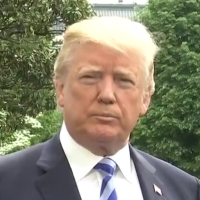 Yet in an exchange with reporters on Air Force One on April 5, Trump denied knowing anything about it, saying, “No. No. What else?” when asked if he knew about the payment to Daniels.
Yet in an exchange with reporters on Air Force One on April 5, Trump denied knowing anything about it, saying, “No. No. What else?” when asked if he knew about the payment to Daniels.
For months, the White House had denied the allegations about the affair and payment. In January, when the Wall Street Journal first broke the story, the White House said in a statement: “These are old, recycled reports, which were published and strongly denied prior to the election.”
In early May, Trump and his personal attorney Rudy Giuliani acknowledged that the payment was made to Daniels, but both claimed that Trump had repaid Cohen through a monthly retainer that wealthy clients typically have with lawyers. Trump claimed he had no knowledge of how Cohen used the retainer. The Justice Department, however, in announcing the plea agreement with Cohen, cited internal company emails and invoices that show “there was no such retainer agreement, and the monthly invoices COHEN submitted were not in connection with any legal services he had provided in 2017.”
Cohen admitted to receiving $420,000 from the Trump Organization to reimburse him for the payment to Daniels, plus expenses and a bonus, and to arranging for a $150,000 payment to a second woman, Karen McDougal, who claimed to have an affair with Trump. Cohen said in court that the payments were made to the two women “for the purpose of influencing the election.”
Cohen pleaded guilty to two counts of campaign finance violations.
On Twitter the week of Dec. 10, Trump called the hush-money, “a simple private transaction,” and said he “never directed Michael Cohen to break the law. He was a lawyer and he is supposed to know the law.”
In a Dec. 16 interview on ABC’s “This Week,” Giuliani accused Cohen of changing his story on the hush-money payments over time. When told “so has the president,” Giuliani responded: “The president’s not under oath.”
Hurricane Maria
On Twitter in September, Trump rejected Puerto Rico’s official estimate of 2,975 hurricane-related deaths after Hurricane Maria, saying the death toll was “6 to 18 deaths.” He falsely claimed Democrats had produced the higher estimate “to make me look as bad as possible.”
Puerto Rico initially estimated there were 64 deaths caused by the hurricane, which hit the island in September 2017, but it later accepted an independent estimate of 2,975 hurricane-related deaths over about six months. Puerto Rico had commissioned the study, which was done by researchers at George Washington University’s Milken Institute School of Public Health.
The study took into account the usual number of deaths that could be expected during the six-month period after the hurricane, and estimated the number of “excess” hurricane-related deaths. Trump misrepresented that methodology, too, wrongly saying the study counted deaths “for any reason, like old age.”
Revisionist Remarks on Russia
In one tweet in February — among many concerning the federal investigation into Russia’s efforts to influence the 2016 election — Trump falsely claimed that he “never said Russia did not meddle in the election.”
He has repeatedly denied or doubted Russia’s involvement in the hacking of the Democratic National Committee’s computers from the first day it became public in June 2016.
The day after the Washington Post reported that Russian hackers had gained access to the DNC’s servers, Trump issued a statement saying, “We believe it was the DNC that did the ‘hacking’ as a way to distract from the many issues facing their deeply flawed candidate and failed party leader.”
Months later, Trump told Time magazine in a Nov. 28, 2016, interview: “I don’t believe they interfered.”
In a Jan. 3, 2017, tweet, Trump dismissed the cyberattack as the “so-called ‘Russian hacking.’”
Three days later, the Office of the Director of National Intelligence released a declassified intelligence report that said Russian President Vladimir Putin had “ordered an influence campaign in 2016” and that Russian intelligence services hacked into the DNC computers and released material to WikiLeaks “to help President-elect Trump’s election chances.”
But Trump continued to cast doubt on Russia’s involvement.
On April 29, 2017, he told CBS News that “if you don’t catch a hacker, okay, in the act, it’s very hard to say who did the hacking.”
See our February story for more examples. Trump’s denial tweet came two days after the special counsel’s office issued an indictment charging 13 Russian nationals and three Russian organizations with illegally interfering in the election.
Months later, in a July 16 joint press conference with Putin in Helsinki, Trump declined to directly respond when a reporter asked whether he believed U.S. intelligence agencies or Putin on whether Russia meddled. “I have great confidence in my intelligence people but I will tell you that President Putin was extremely strong and powerful in his denial today,” Trump said in his answer.
Pushing a Conspiracy Theory
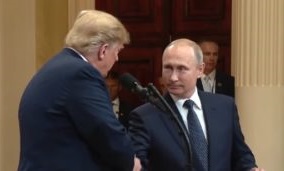 In that same response in the Helsinki press conference, Trump repeated a discredited conspiracy theory about the DNC computer hack when he falsely claimed there were “missing” servers associated with a “Pakistani gentleman that worked on the DNC.” His own Justice Department had shot down that conspiracy theory, saying there was “no evidence” to allegations of stolen equipment or documents.
In that same response in the Helsinki press conference, Trump repeated a discredited conspiracy theory about the DNC computer hack when he falsely claimed there were “missing” servers associated with a “Pakistani gentleman that worked on the DNC.” His own Justice Department had shot down that conspiracy theory, saying there was “no evidence” to allegations of stolen equipment or documents.
Trump had referenced these bogus allegations before, saying in an April tweet that there were “Documents held by the Pakistani mystery man.”
By the time Trump made his remarks in Helsinki, the DOJ had already struck a plea deal on July 3 with former congressional IT staffer Imran Awan, who pleaded guilty to a false statement on an application for a home equity line of credit. U.S. Attorney Jessie K. Liu, who was nominated by Trump, wrote the plea document, which debunked the theories about Awan.
News broke in February 2017 that U.S. Capitol Police were investigating allegations that Awan had stolen equipment and violated House IT policies. Awan worked partly for the offices of Rep. Debbie Wasserman Schultz, chair of the Democratic National Committee from 2011 to the summer of 2016. This sparked conspiracies — floated even by Fox News’ Geraldo Rivera — alleging Awan had something to do with the hacking of DNC computer systems and the release of DNC emails to WikiLeaks.
Yet, after the DOJ investigated and dismissed such allegations of stolen materials — “interviewing approximately 40 witnesses” and examining various electronic devices, it said — the president, in part, answered a question on a world stage about Russian interference in the election by citing the conspiracy theory.
A Fanciful Immigration Tale
Throughout the year, Trump repeatedly claimed, with no proof, that Sayfullo Saipov — the Uzbekistan national who was arrested for a deadly terrorist attack in New York City in 2017 — brought 22 people with him into the United States through “chain migration.” There’s no evidence that Saipov brought even one relative to the country.
Princeton University professor Marta Tienda, a demographer who has studied “chain migration,” told us Trump’s 22 figure was “an implausible exaggeration given the current visa system.”
Saipov came to the U.S. in 2010 through the Diversity Immigrant Visa Program, according to the Department of Homeland Security. Such visa holders may bring a spouse and children, but there’s no indication that happened in Saipov’s case. He married in the United States in 2013.
When he drove a truck into a crowd of pedestrians and bicyclists in New York City, Saipov was a legal permanent resident, a status that is also limited to sponsoring only a spouse and children.
At his midterm campaign rallies, however, Trump would rattle off various family members that he claimed Saipov had brought to the country, including Saipov’s mother and father. That’s false. They were living in Uzbekistan at the time of the attack, as reported by the Daily Mail and the Wall Street Journal.
A Fanciful War Story, Too
In his campaign rallies, the president made false claims about statements he said Sen. Richard Blumenthal had made about the Vietnam War.
Trump claimed Blumenthal “went around telling war stories,” saying he “fought in Da Nang Province” and talked of “soldiers dying left and right as we battled up the hill.” There’s no record of Blumenthal ever saying any of those things.
What’s true is that Blumenthal, a Marine Corps reservist during (but not in) the Vietnam War, wrongly claimed years ago that he “served in Vietnam” and once spoke of the mistreatment of Vietnam veterans “when we returned.” He apologized, saying he had not been “as clear or precise as I should have been.”
But Trump stretched the public record on this incident beyond recognition. As if he were playing his own personal game of telephone, the president added new embellishments as he repeated his tale.
He told a crowd in Kansas on Oct. 6 that Blumenthal “talked about” making rescue attempts during the war. “I went back and I got them, and then I made a second attempt, and bullets are going left and right and over my shoulders and they’re hitting my men,” Trump claimed the senator had said. Again, there’s no record that Blumenthal ever said such things.
Ghost Factories?
The president has shown a pattern for claiming new manufacturing plants were opening, despite no evidence to support his statements:
- “U.S. Steel is opening and expanding seven different plants,” Trump frequently has claimed, once upping the number to “eight or nine.” A U.S. Steel spokeswoman referred us to the company’s website, where all operational changes had
 been posted, she said. We found announcements for a new galvanizing line and the restarting of operations at two blast furnaces and steel-making facilities at an existing plant in Illinois. That’s not “seven different plants.”
been posted, she said. We found announcements for a new galvanizing line and the restarting of operations at two blast furnaces and steel-making facilities at an existing plant in Illinois. That’s not “seven different plants.” - Weeks after Trump imposed a 30 percent tariff on imported solar cells and panels, he claimed: “A lot of places are opening up” to “make solar panels again.” Later, he claimed, “We’re opening up at least five plants,” and then the figure grew to “seven or eight.” Experts told us they knew of one announced facility since the tariffs were implemented.
- After General Motors announced in February that it would close a plant in South Korea, Trump falsely claimed, “and they’re going to move back to Detroit. You don’t hear these things, except for the fact that Trump became president.” GM spokesman Patrick Morrissey told us: “That was not part of the announcement.”
Shifting Responsibility
The president wrongly blamed the Democrats for his own administration’s policy that led to the controversial separation of children from their parents at the U.S.-Mexico border. “I know what you’re going through right now with families is very tough,” he said at the White House on May 16. “But those are the bad laws that the Democrats gave us. We have to break up families. The Democrats gave us that law. It’s a horrible thing. We have to break up families.”
In April, then-Attorney General Jeff Sessions announced a new “zero tolerance” policy on illegal immigration, and the following month, Department of Homeland Security Secretary Kirstjen Nielsen directed her department to refer all unauthorized immigrants who cross the U.S. border to federal prosecutors.
That decision — to criminally prosecute immigrants for illegal entry, as opposed to using a civil removal process — led to parents being placed in detention centers and their children being separated from them. Children can’t be housed in detention centers for adults.
“It is the government’s choice whether to criminally prosecute someone for illegal entry or reentry,” Theresa Cardinal Brown, director of immigration and cross-border policy at the Bipartisan Policy Center in Washington, D.C., told us.
The Trump administration’s policy caused nearly 3,000 children to be separated from their parents and sparked several public protests. Trump backed down on June 20, signing an executive order directing DHS to keep families in custody together “to the extent permitted by law” and the availability of appropriations. According to a Dec. 12 court filing in a case brought by the American Civil Liberties Union, there are still 131 children in custody separated from their parents; however, in more than 90 percent of those cases either the parents have indicated they won’t reunify with their children or officials have found the parents are unfit.
Taking Undue Credit
Politicians are known for taking some undue credit for perceived successes, but Trump brought the practice to a new level when he repeatedly claimed that the 2014 Veterans Choice law was “the greatest idea I think I’ve ever had.”
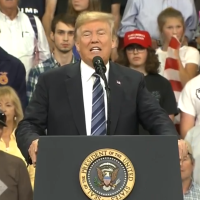 In his detailed anecdotes, Trump claimed he “came back to my group” with the “brilliant” idea to allow veterans facing a long wait for care to see private doctors. “Who else would think of that?” he told a crowd in Pennsylvania on Oct. 10. Ten days later in Nevada, he said, “What a genius — I said, I said, how good is that? They said, ‘Sir, we’ve been trying to get it passed for 44 years.’ So I was good at getting things passed. That’s what I did.”
In his detailed anecdotes, Trump claimed he “came back to my group” with the “brilliant” idea to allow veterans facing a long wait for care to see private doctors. “Who else would think of that?” he told a crowd in Pennsylvania on Oct. 10. Ten days later in Nevada, he said, “What a genius — I said, I said, how good is that? They said, ‘Sir, we’ve been trying to get it passed for 44 years.’ So I was good at getting things passed. That’s what I did.”
In fact, the Veterans Choice Program was created by the bipartisan Veterans Access, Choice, and Accountability Act, signed by President Barack Obama on Aug. 7, 2014. It allowed veterans with long wait times or travel burdens to get care from eligible health care providers outside the Veterans Affairs system.
Trump signed legislation to continue funding the program, and in June, he signed the bipartisan VA MISSION Act, which calls for consolidating Veterans Choice and other private-care options next year into a new Veterans Community Care Program.
Taking Undue Credit, Part II
The president began the year by suggesting he deserved credit for zero commercial passenger jet deaths in 2017 worldwide. On Jan. 2, he tweeted: “Since taking office I have been very strict on Commercial Aviation. Good news – it was just reported that there were Zero deaths in 2017, the best and safest year on record!”
There have been no deaths from U.S. commercial airline accidents since 2009, and no deaths from accidents of foreign air carriers in the U.S. since 2013.
The Aviation Safety Network had reported there were no commercial passenger jet deaths in 2017 worldwide, and a low number of deaths from turbo-prop plane or cargo plane accidents. It said 2017 was “the safest year ever for commercial aviation,” which was also “no surprise.”
“Since 1997 the average number of airliner accidents has shown a steady and persistent decline,” ASN President Harro Ranter said in a press release.
Others Twist the Facts, Too
Trump is an outlier. Nobody comes close to the number of falsehoods that the president has told over the past year.
However, there are some notable whoppers from people who don’t live at 1600 Pennsylvania Avenue.
As with the president, there are many other false claims that we could easily include in this story from others. But we were ruthless in our selection process and limited the number to just six — including one from a foreign leader accused of interfering in the 2016 U.S. presidential campaign.
That’s Not How It Works
Alexandria Ocasio-Cortez, a democratic socialist who will soon represent New York’s 14th Congressional District, has a knack for attracting media attention. So, it wasn’t surprising that PBS interviewed her not long after she upset Rep. Joe Crowley in the Democratic primary on June 26.
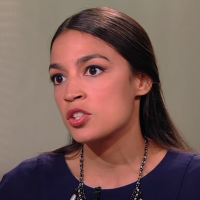 During the July 13 interview, Ocasio-Cortez was asked if “capitalism has failed to deliver for working-class Americans,” even though the unemployment rate is at historically low levels. At the time, the unemployment rate was 4 percent, and it has since dropped to 3.7 percent, as of November, according to the Bureau of Labor Statistics.
During the July 13 interview, Ocasio-Cortez was asked if “capitalism has failed to deliver for working-class Americans,” even though the unemployment rate is at historically low levels. At the time, the unemployment rate was 4 percent, and it has since dropped to 3.7 percent, as of November, according to the Bureau of Labor Statistics.
“I think the numbers that you just talked about is part of the problem, right?” Ocasio-Cortez said, beginning at the 5:32 mark of the video. “Because we look at these figures and we say, ‘Oh, unemployment is low, everything is fine, right?’ Well, unemployment is low because everyone has two jobs.”
Unemployment is not low because more people are working two jobs. That has no bearing on the unemployment rate. Employed people, whether they hold one or more jobs, are only counted once in the unemployment rate calculation.
Nor is the rate of people holding multiple jobs rising, as Ocasio-Cortez implied. At the time of the interview, 4.9 percent of employed people held multiple jobs — which was slightly lower than the 5.1 rate when unemployment peaked at 10 percent in October 2009 during the recession. (Dual jobholders remains at 4.9 percent, as of November.)
The ‘No. 1 Cause of Sea Level Rise’
Alabama Rep. Mo Brooks, a member of the House Science, Space and Technology Committee, falsely claimed in a May 19 op-ed that erosion caused by river sediment deposits and falling rocks is “far and away the #1 cause of sea level rise.”
“Over the history of planet Earth, far and away the #1 cause of sea level rise has been erosion and its resulting deposits of sediment and rocks into the world’s seas and oceans,” he wrote, adding, “There is no close second cause of sea level rise.”
That’s false — far and away.
According to a 2017 report by the U.S. Global Change Research Program, global sea level rise is “primarily driven by two factors,” both directly related to global warming.
First, the oceans are expanding because water swells as it gets warmer. According the National Oceanic and Atmospheric Administration, the “oceans are absorbing more than 90 percent of the increased atmospheric heat associated with emissions from human activity.” Second, there is also more water in the oceans because mountain glaciers and the Antarctic and Greenland ice sheets are melting, explains the 2017 report.
Brooks discussed his novel theory of sea level rise at a May 16 hearing of the House science committee. But one expert witness — Philip Duffy, a physicist and the president of the Woods Hole Research Center, a climate change think tank — instantly debunked Brooks’ claim. “I’m pretty sure that on human time scales those are minuscule effects,” Duffy said.
Brooks wasn’t the only Republican committee member who got his facts wrong at that hearing, which turned into a fact-checking bonanza. Among other things, Rep. Lamar Smith, the committee chairman, falsely claimed there’s “no correlation” between sea level rise and carbon emissions, and Florida Rep. Bill Posey was wrong when he said the last ice age “was caused by a cataclysmic collision of an asteroid.”
Schiff’s Golf Fable
Rep. Adam Schiff, the ranking Democrat on the House intelligence committee, is a frequent Trump critic. On CNN’s “New Day,” Schiff criticized the president for forcing the federal government “to patronize Trump-related businesses,” such as Trump golf properties. But, when it came to a specific example, Schiff’s shot against Trump landed out of bounds.
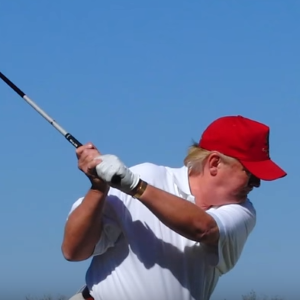 Schiff wrongly claimed that the Secret Service had paid the Trump Organization “over $150,000 … for the privilege of renting Donald Trump golf carts to protect Donald Trump on his rounds.” The money went to two companies, but they weren’t “Trump-related businesses.” And the vehicles were not “Donald Trump golf carts.”
Schiff wrongly claimed that the Secret Service had paid the Trump Organization “over $150,000 … for the privilege of renting Donald Trump golf carts to protect Donald Trump on his rounds.” The money went to two companies, but they weren’t “Trump-related businesses.” And the vehicles were not “Donald Trump golf carts.”
At the time, Schiff’s office told us that the $150,000 figure came from a November 2017 USA Today story that cited the work of American Bridge 21st Century PAC, a Democratic opposition research group. American Bridge provided us with its research, which showed that the Secret Service rented golf carts from Golf Car & Utility Vehicle Distributors in Florida and Associates Golf Car Service of Poughkeepsie, New York.
“We haven’t found the contracts going to any Trump companies,” American Bridge spokesman Harrell Kirsten told us.
Corporate Tax Revenues Didn’t Rise
Three months after the Tax Cuts and Jobs Act took effect, House Speaker Paul Ryan — a key player in the passage of the tax bill — pushed back at the notion that the new law would increase annual federal deficits.
During an April 15 appearance on NBC’s “Meet the Press,” Ryan was asked to respond to criticism from a fellow Republican, Sen. Bob Corker, that the tax bill will drive up annual deficits. In response, Ryan blamed rising deficits on mandatory spending, not the tax bill. He went on to falsely claim: “Corporate income tax revenues. Corporate rate got dropped 40 percent, still rising.”
The tax bill, among other things, reduced the top corporate tax rate from 35 percent to 21 percent, beginning in January 2018. That has resulted in lower corporate tax revenues.
At the time of Ryan’s statement, the nonpartisan Congressional Budget Office had just announced in an April 6 report that corporate tax revenues for the first six months of the year were down $22 billion – a 22.3 percent decline from the first six months of fiscal year 2017.
For the full fiscal year, which ended Sept. 30, corporate tax revenues were down $92 billion — a decline of 31 percent from the previous fiscal year, according to CBO. “About half of the decline has occurred since June,” as a result of the tax law changes, “the new lower corporate tax rate and the expanded ability to immediately deduct the full value of equipment purchases.”
The federal budget deficit was $779 billion in fiscal year 2018, $113 billion more than the shortfall recorded in fiscal year 2017, according to the Treasury Department’s final statement for the fiscal year. In a June report, CBO projected that the tax act — even after accounting for economic effects — “would increase primary deficits by $1.272 trillion through 2028.”
A Misleading Democratic Talking Point
Anyone with a TV, computer or radio during the midterm elections probably heard that 83 percent of the Republican tax cuts go to the wealthiest 1 percent. That’s grossly misleading.
The Democrats started using this misleading talking point immediately after Trump signed the Republican tax legislation into law a year ago and repeated it throughout the midterm elections. It is based on cherry-picking an analysis by the Tax Policy Center released on Dec. 18, 2017.
The Tax Policy Center estimated the effects of the tax cuts on various income groups for three years: 2018, 2025 and 2027. In 2018, according to the Tax Policy Center, the top 1 percent of income earners (those earning above $837,800) would receive 20.5 percent of the tax cut benefits — a substantial amount, but not 83 percent. In 2025, the top 1 percent’s share of the tax cut would grow slightly to 25.3 percent — still not 83 percent.
It is not until 2027 that the percentage of tax benefits to the top 1 percent jumps to 82.8 percent, and that’s only “because almost all individual income tax provisions would sunset after 2025,” as the TPC report explains. (A major reason: The top 1 percent still benefits from some of the remaining tax cuts, such as reducing the top corporate tax rate.)
The Republicans wrote an expiration date in the bill so that they could pass it through budget reconciliation with only a majority vote in the Senate. Under reconciliation, the bill could not add more than $1.5 trillion to the deficit over 10 years or add to the deficit beyond a 10-year period.
Republicans have said they want to extend these expiring income tax cuts, and Democrats have said they want to “repeal and replace” the GOP-crafted tax law. Both options would likely reduce the top 1 percent’s share of the tax cut benefits in 2027 and beyond.
We can’t predict the future, but we can say that the Democrats this past year have repeatedly distorted the actual impact of the tax law by cherry-picking the 83 percent figure.
Putin’s Whopper
In what is a first for us, a foreign leader has made our annual whoppers list and, perhaps fittingly, it is Russian President Vladimir Putin — the man who U.S. intelligence agencies say directed a multipronged influence campaign during the 2016 presidential election in an attempt to help Trump defeat Clinton.
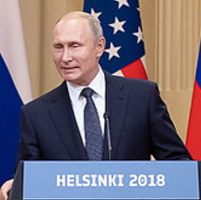 Putin lands on our list for his comment during his joint press conference with Trump at the Helsinki summit on July 16. The Russian leader falsely claimed that business associates of William Browder, who had lobbied for a 2012 U.S. law sanctioning Russians, “sent a huge amount of money – 400 million – as a contribution to the campaign of Hillary Clinton.” (To put the $400 million in perspective, we note that the Clinton campaign raised a total of $563.8 million, and outside groups supporting her campaign raised another $231 million.)
Putin lands on our list for his comment during his joint press conference with Trump at the Helsinki summit on July 16. The Russian leader falsely claimed that business associates of William Browder, who had lobbied for a 2012 U.S. law sanctioning Russians, “sent a huge amount of money – 400 million – as a contribution to the campaign of Hillary Clinton.” (To put the $400 million in perspective, we note that the Clinton campaign raised a total of $563.8 million, and outside groups supporting her campaign raised another $231 million.)
Who is William Browder? He’s the founder and CEO of Hermitage Capital Management who angered the Russian government by helping to pass the 2012 Magnitsky Act, which banned some Russians from entering the United States and froze their assets held in U.S. banks. His investment company at its peak managed more than $4 billion in assets before the Russian government sued Browder for tax evasion — forcing Hermitage’s lucrative Russia fund to shut down in 2013.
Although he was born in the United States, Browder renounced his citizenship in 1998, so cannot make campaign contributions, and we could find no contributions from any employees of Hermitage in the 2016 cycle.
So what was Putin talking about?
At a June 2016 meeting in Trump Tower with Donald Trump Jr., and other Trump campaign officials, Russian lawyer Natalia Veselnitskaya arrived with talking points — later published by the New York Times in 2017 — that said the Ziff Brothers “took part in financing both Obama” campaigns and that “[i]t cannot be ruled out that they took part in financing the campaign of Hillary Clinton.” In a 2017 interview with the Wall Street Journal, Veselnitskaya said she told the Trump campaign at the meeting that Browder had worked with Ziff Brothers Investments, and that the firm had dodged taxes in Russia and later donated to Democrats.
But those affiliated with the Ziff Brothers gave just $17,700 to Clinton’s campaign in 2016, according to the Center for Responsive Politics. And their donations to other Democratic committees — $1.1 million — don’t come anywhere close to Putin’s $400-million accusation.
For his part, Browder in an op-ed for Time magazine called Putin’s claim “so ludicrous and untrue that it falls into delusion.”